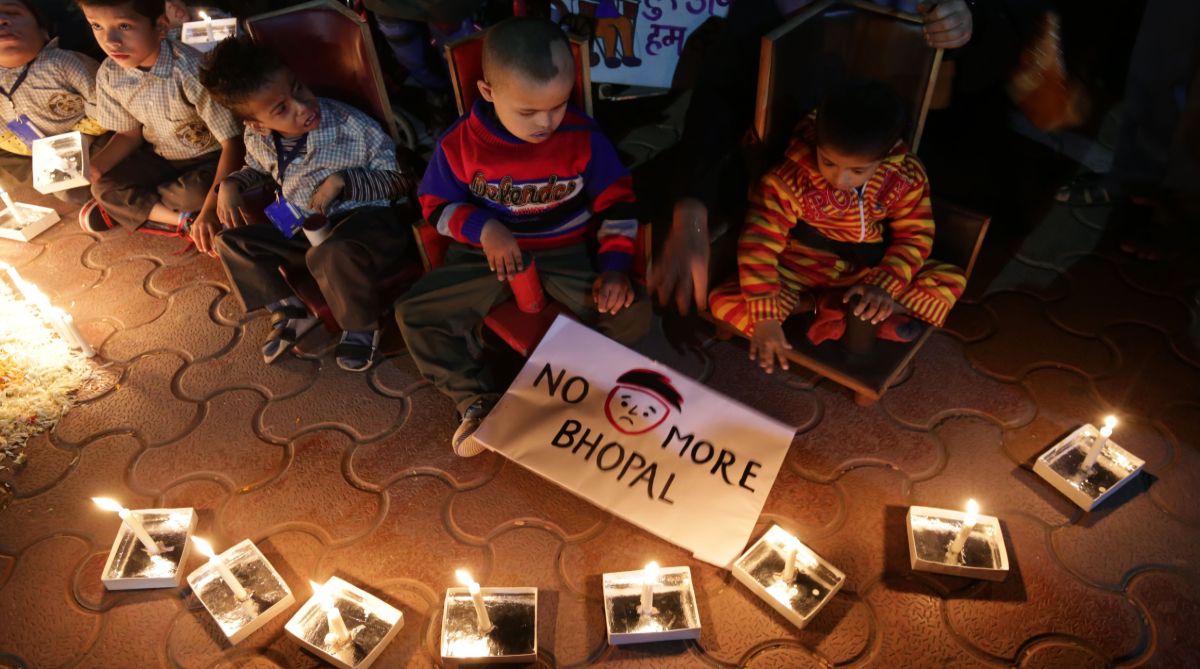Assam’s grand Jhumoir show: 8,000 performers, PM Modi to attend
Assam’s Jhumoir Binandini event on February 24 will feature over 8,000 performers showcasing the traditional Jhumoir dance at Sarusajai Stadium, Guwahati.
Many organizations working for the gas relief and hundreds of victims and their family members gathered outside the now-closed Union Carbide factory at Jai Prakash Nagar in Bhopal on Monday morning.

Children of third generation gas victims attend with relatives a candlelight vigil held by various gas victim organisations to commemorate Bhopal gas disaster in Bhopal on December 1, 2018. - Thousands of people lost their lives on the night of December 2, 1984, when a cloud of highly toxic methyl isocyanate gas spewed from a Union Carbide factory in Bhopal and blew across the city. (Photo by Gagan Nayar / AFP)
The 34th anniversary of the 1984 Bhopal Gas Tragedy, the world’s worst industrial disaster, was observed on Monday amidst protests about water contamination and thousands of tons of hazardous waste still lying exposed in the Union Carbide factory premises in Bhopal, which, ironically, has won the award for being the country’s second cleanest city for two successive years.
“I had written a letter last year to Prime Minister Narendra Modi about this toxic waste but till date I have received no response from him or his office,” lamented Abdul Jabbar, one of the most notable activists working for the welfare of the gas victims ever since the disaster took place.
Advertisement
“We believe that besides the hazardous waste on the ground and in the soil, the toxic waste has seeped underground too and our estimate is that presently there must be at least 20,000 metric tons of hazardous waste,” Jabbar told The Statesman. He said the estimate was reached after calculating the 65 acres land area of the factory and the water ponds spread in another 20 acres of the Union Carbide premises.
Advertisement
“Given this fact, Bhopal should not even be allowed to compete in the Clean City contest, leave aside being awarded second position twice in a row,” averred Jabbar, who is the convener of the Bhopal Gas Peedit Mahila Udyog Sangathan. Many organizations working for the gas relief and hundreds of victims and their family members gathered outside the now-closed Union Carbide factory at Jai Prakash Nagar in Bhopal on Monday morning. They took out a ‘Black Rally’ holding banners and shouting slogans against Union Carbide, Dow Chemicals, the central government and the state government for utter indifference towards the gas affected people of the city.
Many of the protestors on Monday expressed anguish at the fact that Bhopal has been winning the award for the country’s second cleanest city for the past two years in a row despite the fact that it still sits on contaminated underground water from the Union Carbide and thousands of tons of toxic waste still lies in the heart of the city. One of the banners in the hands of the victims and the protestors read, ‘Mourn the Dead, Fight for the Living.’
Effigies of Dow Chemicals, Warren Anderson were burnt as a mark of protest and the victims lamented the fact that they were still forced to drink contaminated water and live in close vicinity of thousands of tons of toxic waste, which subsequent governments at the centre and in the state have failed to dispose off in the past 34 years.
A joint study by the Centre for Science and Environment (CSE) and the Central Pollution Control Board (CPCB) in 2009 had found soil and groundwater to be contaminated with heavy metals and chemicals. A test conducted in 2015 had found the water from 240-foot-deep bore wells to be contaminated.
Over six lakh people were exposed to the leakage of Methyl Isocyanate from the Union Carbide factory in Bhopal on the night of December 2-3, 1984. An estimated 15,000 people have died due to the toxic gas.
Advertisement